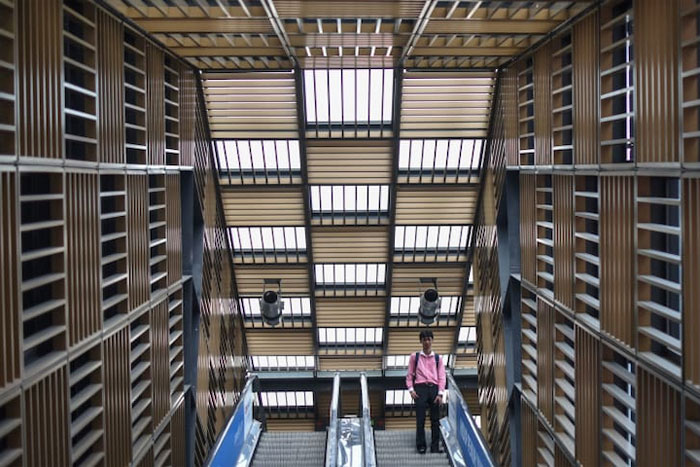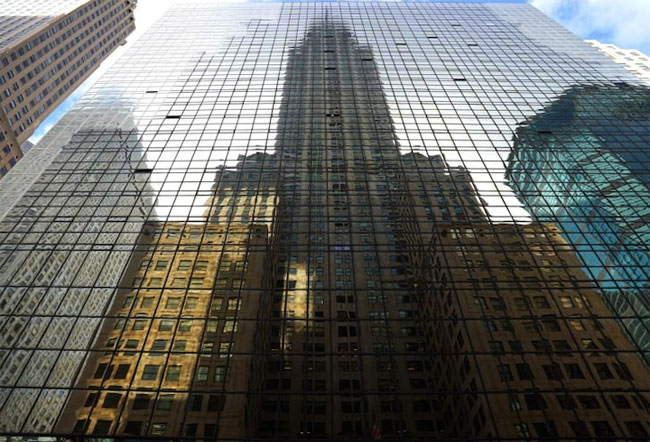You are sitting at your desk at 3 PM. You feel you can’t concentrate anymore and decide to look out the window for a moment to relax your mind. But instead of feeling comfortable, you find yourself with an even worse headache.
The gray, tangled streets below, the repeated window panes of the building across the street. With the monotonous straight lines that your eyes see, there’s no pleasant scenery for your brain to relax. Scientific research has shown that urban imagery can cause headaches.

Looking at these buildings, instead of feeling comfortable, you find yourself with an even worse headache. (Photo: AFP/Getty Images).
Over tens of thousands of years, the human brain has evolved to process images of nature effectively. However, urban imagery poses a significant challenge to the brain due to its repetitive patterns.
Mathematician Jean-Baptiste Joseph Fourier stated that we can view the scenery created from straight lines of varying sizes, directions, and positions, all combined together. These patterns are referred to as Fourier components.

Natural scenery features lines that cancel each other out, so when combined, they do not form straight lines, whereas urban scenery tends to repeat common patterns. (Photo: Sam Beebe, Tsaiian/Flick)
Difficult to View
As a general rule, components in nature have low spatial frequencies (larger lines) with high contrast, while those with high spatial frequencies (smaller lines) have lower contrast. We can refer to the simple relationship between spatial frequency and contrast as “natural law.” To clarify, the lines in natural scenery tend to cancel each other out, so when combined, they do not form straight stripes.
But in urban environments, it’s different. Urban scenery does not adhere to natural laws; they tend to follow repetitive patterns due to the use of identical designs like windows, staircases, and railings. Yet, these patterns rarely appear in nature.

Because the patterns in urban architecture break natural laws, they make it difficult for the human brain to process information. (Photo: MOHD Rasfan/Getty Images).
The repetitive patterns in urban architecture do not follow natural laws, causing our brains to process them less efficiently. And because urban scenery is harder to process, we do not feel comfortable when gazing at them. Some patterns, such as the lines of curtains, carpets, or spiral staircases, can induce headaches or even seizures in viewers.
Researchers reached this conclusion by measuring the efficiency of the brain in processing images of nature versus urban images. There are two ways to measure this: the first is to design a simple computer program that simulates how neurons process the images we see.
A computer program was developed by Paul Hibbard (University of Essex) and Louise O’Hare (University of Lincoln). Additionally, another model was created by Olivier Penacchio (University of St Andrews) and his colleagues. Both models showed increased neuronal activity when the brain processed images that did not adhere to natural laws, and they became less dispersed. In other words, the brain needs to work harder to process those images.

Bibliotheque nationale de France after renovation in 2016. (Photo: Francois Guillot/AFP).
For the study, Olivier and his colleagues designed a computer program to calculate the degree of adherence to natural laws of any image. After running the program, scientists found differences in the degree of adherence to natural laws related to the viewer’s comfort level regarding any image, whether it was a building or a painting.
Subsequently, the scientists analyzed images of apartment buildings and observed that over the past 100 years, the exterior designs of buildings have increasingly deviated from natural laws. Over decades, the designs of homes have featured more and more straight lines, making them increasingly uncomfortable to look at.
Oxygen
Another way to measure the brain’s efficiency in processing images is to measure the amount of oxygen used by the visual part of the brain located at the back of the head. When the brain uses oxygen, it changes color. Scientists can detect any changes by shining infrared light on the scalp and measuring the amount of light scattered after reflecting from the brain and passing through the skull. Typically, the brain uses more oxygen when looking at uncomfortable images, such as images of an urban environment.

Scientists found that the architecture of buildings is uncomfortable to look at. (Photo: Timothy A. Clary/AFP).
Researchers also discovered that natural laws not only indicate comfort levels but also show the amount of oxygen the brain uses. Specifically, our brains use more oxygen when viewing images that adhere less to natural laws. Since headaches are a symptom related to excessive oxygen use, this may explain why certain buildings can cause us to feel headaches when we look at them.
Individuals suffering from migraines particularly struggle with repetitive patterns; these patterns cause the brain to use more oxygen (while the brains of migraine sufferers already consume unusually high amounts of oxygen). This could be the reason why looking at repetitive patterns can trigger headaches for them. In fact, many migraine sufferers cannot work in modern office buildings because the straight lines make them feel headaches every time they enter the building.
Perhaps it is time for us to apply natural laws more in the design of buildings and offices. Or interior designers could vary wallpaper, curtains, and carpets to avoid having too many straight lines inside homes.
Of course, the repetition of certain patterns in modern architecture is unavoidable. However, the excessive use of straight lines is truly unnecessary; they merely serve to make the building’s design more visually appealing. Unfortunately, our brains do not get to enjoy that.




















































